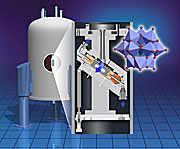- Number 357 |
- February 27, 2012
Studying the chemistry as it happens in catalytic reactions

The new device is called a
large-sample-volume
constant-flow magic angle
spinning probe for use in a
nuclear magnetic resonance
spectrometer.
While retaining their speed, catalysts have lost some of their secrets, thanks to a new probe built by scientists at DOE’s Pacific Northwest National Laboratory to help clarify the steps catalysts take in promoting reactions. The new device is called a large-sample-volume constant-flow magic angle spinning probe for use in a nuclear magnetic resonance spectrometer. With it, scientists can flow a gaseous reaction mixture through a solid catalyst and collect NMR data on the intermediates and products generated during the reaction. In addition, using NMR can provide structural information about the catalyst itself during the reaction.
"Scientists have been trying for a long time to get something closer to a realistic environment with NMR data. This is the newest approach to doing that," said Dr. Charles Peden, a catalysis researcher in the Institute for Integrated Catalysis at PNNL who worked on the study.
That realistic environment is valuable with catalyzed reactions, as catalysts are involved in ~90% of all commercially produced chemical products, from refining gasoline to manufacturing margarine. Making existing catalysts more effective or devising new ones could reduce costly inefficiencies in current processes or enable new ways to produce fuels and chemicals. To improve existing and invent new catalysts and catalytic processes, scientists need data about the steps that occur during the reaction. With this new probe, scientists get that type of detailed information via NMR spectroscopy.
"NMR is a powerful technique. Being able to apply it to catalytic reactions while they are occurring has been a really tough problem. This new in situ NMR probe lets us perform experiments we couldn't do before," said Dr. Jian Zhi Hu, the lead PNNL scientist on this study.
And, soon scientists around the world will be able to use this new tool via DOE’s EMSL user proposal process.
This research was funded by the DOE Office of Basic Energy Sciences, Chemical Sciences, Geosciences, and Biosciences Division.
[Kristin Manke, 509.372.6011,
kristin.manke@pnnl.gov]
